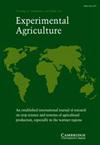墨西哥中部小规模乳制品生产系统在减少农村贫困中的作用
IF 1.9
4区 农林科学
Q1 Agricultural and Biological Sciences
引用次数: 0
摘要
摘要本研究的目的是从性别角度分析墨西哥中部小型奶牛场在消除农村贫困方面的作用。具体而言,确定了这些生产系统是否产生了足够的收入来减轻贫困和购买基本食品篮。通过雪球抽样选出了212名农民。为了保持性别观点,女性户主农场被视为一个独立的群体,男性户主农场根据多元统计数据进行分组。经济分析中考虑了两个官方贫困指标:收入和极端贫困线。因子分析确定了四个因素,解释了66.10%的累积方差。聚类分析确定了五组以雄性为首领的农场。然后,对包括女性户主组(FG)在内的六组进行了比较分析。经济分析显示,如果52%的收入是生产成本,则第1、2、3和4组产生的总收入足以为该地区的家庭购买基本食品篮。然而,FG和第5组没有产生足够的总收入来购买食品篮。相比之下,如果70%的收入是生产成本,那么只有第1组和第4组产生了足够的总收入。可以得出的结论是,小型奶牛场在某些条件下产生了足够的日常收入,用于购买基本食品篮,因此有助于消除农村家庭的贫困,特别是第1组和第4组的贫困。就FG和第2、3和5组而言,乳制品生产以及生产活动和后院活动的多样化为农村家庭的生计提供了支持。建议进一步探讨现有的性别规范,因为这些规范可能直接影响农民,特别是女性生产者采用或拒绝农业和畜牧业技术的动机。本文章由计算机程序翻译,如有差异,请以英文原文为准。
Role of small-scale dairy production systems in central Mexico in reducing rural poverty
Abstract The aim of the study was to analyze the role of small-scale dairy farms in central Mexico in combating rural poverty from a gender perspective. Specifically, it was determined whether these production systems generated sufficient income for alleviating poverty and purchasing the basic food basket. Two hundred and twelve farmers were selected through snowball sampling. To maintain a gender perspective, female-headed farms were considered as an independent group, and male-headed farms were grouped according to multivariate statistics. Two official indicators of poverty were considered in the economic analysis: income and the extreme poverty line. Factor analysis identified four factors that explained 66.10% of accumulated variance. The cluster analysis identified five groups of farms headed by males. Then, a comparative analysis was carried out for the six groups, including the female-headed group (FG). The economic analysis revealed that, if 52% of income are production costs, groups 1, 2, 3, and 4 generated sufficient gross income to purchase the basic food basket to the household of the area. However, the FG and group 5 did not generate sufficient gross income to purchase the food basket. In contrast, if 70% of income are productions costs, only groups 1 and 4 generated sufficient gross income. It can be concluded that small-scale dairy farms generate sufficient daily income under certain conditions for the purchase of the basic food basket and, therefore, help to fight poverty in rural families, especially in groups 1 and 4. In the case of the FG and groups 2, 3, and 5, dairy production along with the diversification of productive activities and backyard activities supports the livelihoods of rural families. It is recommended that existing gender norms be further explored because these could directly influence the motivation of farmers, particularly female producers, to adopt or reject agricultural and livestock technologies.
求助全文
通过发布文献求助,成功后即可免费获取论文全文。
去求助
来源期刊

Experimental Agriculture
农林科学-农艺学
CiteScore
2.50
自引率
6.20%
发文量
29
审稿时长
24 months
期刊介绍:
With a focus on the tropical and sub-tropical regions of the world, Experimental Agriculture publishes the results of original research on field, plantation and herbage crops grown for food or feed, or for industrial purposes, and on farming systems, including livestock and people. It reports experimental work designed to explain how crops respond to the environment in biological and physical terms, and on the social and economic issues that may influence the uptake of the results of research by policy makers and farmers, including the role of institutions and partnerships in delivering impact. The journal also publishes accounts and critical discussions of new quantitative and qualitative methods in agricultural and ecosystems research, and of contemporary issues arising in countries where agricultural production needs to develop rapidly. There is a regular book review section and occasional, often invited, reviews of research.
 求助内容:
求助内容: 应助结果提醒方式:
应助结果提醒方式:


